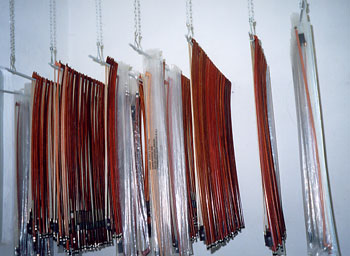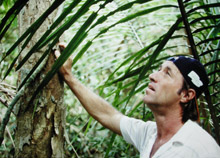Saving Forests, One Bow at a Time
Air Date: Week of May 23, 2003
Instrument bows are made almost entirely from one type of wood, and that wood is endangered in its native Brazil. Living on Earth’s Cynthia Graber reports on the bow-makers’ efforts to help save the trees, and save their craft.
Transcript
CURWOOD: When Portuguese explorers reached the New World in 1500, they discovered a tree that produced wonderful dyes, reds, browns and oranges. The called the tree “pau brasil,” and soon the land where this tree grew also became known as Brazil. Millions of pau brasil trees were cut down to supply the dye trade. That practice ended in the mid-1800s with the development of chemical dyes but demand for the trees continued.
Today, more than 90 percent of Brazil's Atlantic coastal forest is gone and development pressures threaten the rest. Now, an international group is trying to help save what's left of the forest because of their strong connection to the pau brasil tree. Living on Earth's Cynthia Graber explains.
[SOUND OF VIOLIN MUSIC]
GRABER: Michael Rosenbloom leans over his violin and listens carefully. Rosenbloom is concert master with the Boston Ballet. He also plays with Boston Pops and Boston Symphony. Today, at a violin shop near Symphony Hall, he's testing a new bow.
[SOUND OF VIOLIN]
GRABER: Rosenbloom says he owns about a dozen bows, each with its own personality.
ROSENBLOOM: Some of them have a lighter touch. Some of them sink into the string more. But I have to admit, there are times, especially in the pit down at the ballet, if I have a solo to play and the piece has two different styles in it, sometimes I'll take two bows down there and switch in the middle.
GRABER: To obtain the perfect bow, some musicians will pay up to $3,000 to craftsman like Tom Dignan.
[SOUNDS OF SCRAPING]
DIGNAN: Can you hear that? Doesn't that sound beautiful?
GRABER: As Dignan scrapes a hand-made plane down a stick of wood he's carving into a violin bow, fiery orange shavings float through the air and coat his workshop near Boston with a fine layer of dust.
DIGNAN: A great bow--the maker has, generally, a very choice piece of wood that has been worked just enough so that it's strong, but resilient and flexible at the same time. It's in your hand. You can feel it in your hand.

Violin bows made of Pau Brasil wood.
(Photo: Cynthia Graber)
GRABER: To make a perfect bow, you need the perfect wood, and it's found only in the Atlantic coastal forest of Brazil. It's called pernambuco, or pau brasil in Portuguese, and it has the flexibility, durability, and resilience, plus rich hues ranging from oranges to dark reddish-browns that bowmakers crave. But today, the pau brasil tree's survival is at risk. Up until the mid-1800s, vast numbers of trees were cut and exported to support Europe's dye trade. Today, habitat loss from urban development and farm expansion threatens remaining trees. And protecting the tree is complicated.
In Brazil, it's illegal to cut pau brasil trees. But people skirt the law by securing permits to clear land for farming or to build homes, and then they're allowed to sell any pau brasil they find on the property. So in 1997, the group Flora & Fauna International invited scientists, conservationists, wood exporters, and bowmakers to discuss the future of the tree. The meeting was a wake-up call for bowmakers who never considered the state of the natural resource or their role in its depletion.
DIGNAN: And certainly, when the minutes from the meeting were published, and we all had a chance to look at that, we became aware of how critical the issue of conservation and how rarified the species seems to be getting in the Atlantic forest of Brazil.
GRABER: It's hard to find pau brasil trees in the wild. But Floriano Schaeffer knows where they are. We're in the state of Espirito Santo, about eight hours north of Rio de Janeiro.
SCHAEFFER: [PORTUGESE] Here's some pau brasil that I planted two months ago.
 Floriano Schaeffer is one of a number of Brazilian bowmakers growing Pau Brasil trees. (Photo: Arcos Brasil) Floriano Schaeffer is one of a number of Brazilian bowmakers growing Pau Brasil trees. (Photo: Arcos Brasil) |
GRABER: Schaeffer is part of a community of Brazilian bowmakers who know the importance of conserving their precious resource. Schaeffer was 12 years old when he began cutting wood. A few years later, he made his first bow. Today, he owns his own bowmaking company. He's also what Brazilian's call a matero, somebody truly at home in the mata, the forest.
SCHAEFFER: [PORTUGESE] There is pau brasil. There's another one. GRABER: Schaffer pulls a baseball cap low over his forehead and races through the forest. He shows me the places he's been planting over the past three decades. His business partner, Celso de Mello points to the results. DE MELLO: Seedlings. Seeds from the trees that he planted 25 years ago. This is growing by itself now, you know. GRABER: Bowmakers have just started growing pau brasil trees on plantations, but forests are still the ideal location. In the forest, trees must compete for bits of light that push through the tree-lined canopy high above. So new trees grow straight and tall, good for making bows. And de Melo says there are other benefits to growing in the wild. DE MELLO: If you plant it here, you don't have to water it that much. If you plant it under the sun, you've got to water it a lot. So here nature takes care of that. If it rains, the soil, the earth is going to be moist for many, many days, which is really good for the plant. GRABER: After growing for 40 years or so, a tree can provide enough wood for hundreds of bows. DE MELLO: This is a very nice tree. Look at that. GRABER: The tree stands straight, no twists, few branches, and the bark is peeling off, a clue that deep, reddish-brown heartwood lies within. DE MELLO: This is about 10 years old, and it's got the heart inside already. GRABER: Schaeffer and de Mello turn pau brasil wood into exquisite bows in an airy concrete building about a 20-minute drive from the forest. Dogs guard the precious wood stacked outside. Schaeffer pulls them away and explains how each piece is unique. SCHAEFFER: [PORTUGESE] I feel how solid the wood is, and I hear the sound. This is a violin. This one is a viola, a cello, because it's heavy. GRABER: Schaeffer sells his best wood to bowmakers abroad, and makes lower cost bows with the rest. Schaeffer is committed to putting back into the forest what he takes out. So he and his partner, Celso de Mello bought a 20-acre farm they're slowly replanting. One area is mostly pau brasil, but de Mello says, soon, other native trees will follows. DE MELLO: We've got to plant first the fruit trees, bring the birds back, animals, and then we start with the second line of trees. And then the pau brasil is going to be the third. We got to bring the whole forest back. GRABER: Brazil's four bowmaking companies have been replanting pau brasil for years. It's a small conservation effort that will need a broader scope if pau brasil trees are to be saved. RAUBECHEK: I got up on this wharf and I looked out over the vast grassland that I knew once before was a forest. And it finally hit me in my conscience, my heart. It finally sunk in. I couldn't cut any other tree. It was like destroying a human. GRABER: Al Raubechek cut pau brasil illegally for more than two decades. He'd go into the forest with saws and oxen and take out trees. Today, he runs a legal salvage business, buying up old fence posts made from pau brasil, or finding the wood left in fields. But Robicsek says poaching continues unabated, because some bowmaking companies are willing to buy wood without asking many questions. RAUBECHEK: People that supply me with deadwood tell me they are giving it to the other folks. I know, the buyers for the other folks are down there, and they're contracting trucks to bring out logs. I know where they were hiding logs right near my house. So, I mean, these are the clues and elements to let me know that they're doing this. It just kills me. The only thing I can do is not to do it. GRABER: Two years ago, the international bow-making community got together to form the International Pernambuco Conservation Initiative. Their goals: protect their craft and save the trees that support it. [SOUND OF SCRAPING] GRABER: Back in Boston, bowmaker Tom Dignan points to the piles of brownish-red slabs stacked against the wall, and tells me he can survive any crisis. DIGNAN: Basically, I think I almost have enough wood for myself for the few years that my eyes and hands will hold out. GRABER: Dignan says he knows the pau brasil trees he's protecting in some faraway land are not meant to ensure his livelihood. It's the future of his craft he's concerned about. DIGNAN: I would say, all my colleagues feel the same way. We know we're not going to reap the benefits of the trees that get planted, but we feel, really, it's important. It's really very important to all of us that it doesn't disappear either. [SOUND OF VIOLIN] GRABER: The international bow-making community says its next step to save pau brasil trees is to involve musicians, the final users of the product, in the conservation effort. For Living on Earth, I'm Cynthia Graber. [VIOLIN MUSIC] Living on Earth wants to hear from you!Living on Earth Newsletter [Click here]
Donate to Living on Earth! NewsletterLiving on Earth offers a weekly delivery of the show's rundown to your mailbox. Sign up for our newsletter today!
|





